![]()
![]()
![]()
Use LEFT and RIGHT arrow keys to navigate between flashcards;
Use UP and DOWN arrow keys to flip the card;
H to show hint;
A reads text to speech;
10 Cards in this Set
- Front
- Back
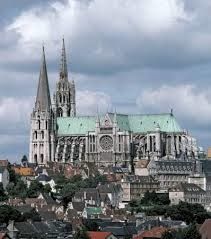
|
Chartres Cathedral Date: 1200 (Rebuilt after 1194) Period: Early Gothic and later High Gothic Artist: Unknown Function: Served as both a place of worship for followers of the Christian faith as well as a great example of Early Gothic architecture before its destruction. Its size emphasizes the importance of the religion in France Context: The lower parts of the west towers and the portals are all that lasted after a fire destroyed it. Although it was later rebuilt into a High Gothic style, it still maintained the Romanesque influence it originally had. Descriptive terms: grand, high, innovative Ideas relevant to the work of art: The west portals represent the glory of God and His Majesty; the apse is near the top of the cross. Each portal/ church has its own theme. The west portals have several tympanums that represent the glory of God and those on earth who follow him. Materials: Stone, glass Patron: Thierry of Chartres, visitors of the cathedral
|
|
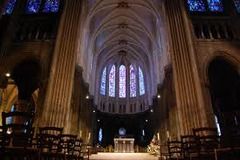
|
Plan and Nave, Chartres Cathedral Date: 1200 Period: French Gothic Artist: Unknown Function: Its awesome size made for a sense of reverence and fear due to the new massive structures and to the power emphasized for Christianity through art, such as the increasingly high arches and the lux nova that penetrates through the stained-glass windows. Context: New organization rectangular base, didn't use square. Some of the rectangles in different places are proportionate to one another. Descriptive terms: design, interior, grand Ideas relevant to the work of art: The interior makes people feel small; the flying buttresses holds up the building and make for a gigantic center of worship as well as fear and reverence. There was also a new nave elevation which made for larger window areas; the stained-glass art transformed light through its different colors (lux nova, or Light of Christ). Materials: Stone, glass Patron: visitors of the Cathedral
|
|
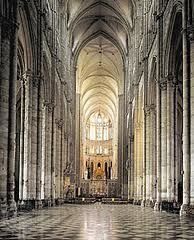
|
Plan and nave, Amiens Cathedral Date: 1200 Period: French Gothic Artist: (For the nave) Robert de Luzarches, Thomas de Cormont, and Renaud the Cormont. Function: Meant to serve as a place of a worship within the Christian religion; represented the French Gothic style with continuously taller buildings. Context: The nave was completed by 1296 and included refines details from older Gothic works. The Amiens Cathedral is representative of the Gothic obsession with continuously creating larger and larger buildings. Descriptive terms: Elevated, high, tall, massive, intimidating, arched, blended and natural (colors), detailed. Ideas relevant to the work of art: Almost every part of the superstructure has a corresponding element below it. Like other buildings, this one also follows the rule of three in terms of portals with tympanum a (largest in the center); 3 was a holy number in Christianity because it represented the Holy Trinity. Materials: Stone, glass Patron: visitors of the Amiens Cathedral |
|
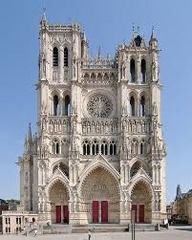
|
Amiens Cathedral Date: 1200 Period: French Gothic Artist: Robert de Luzarches. Thomas de Cormont, and Renaud de Cormont. Function: Meant to serve as a place of worship for followers of the Christian religion; a great example of the Gothic love for high buildings (the architects pushed themselves to make the structure as tall as humanly possible); a pillar of faith for the local Christian religion. Context: Work began on the Amiens west facade at the same time same time as the nave (1120); the lower parts appear to pay homepage to the Laos cathedral. The uneven towers were later additions to the cathedral. Descriptive terms: High, elevated, detailed, natural in colors Ideas relevant to the work of art: The building left large spaces for decoration which appear to be covered with arches, colonettes, pinnacles, and rosettes, among others. Sculpture extends to the areas above the portals, especially the band of statues running the full width of the facade below the rose windows. Materials: Stone, glass Patron: visitors of Amiens Cathedral |
|
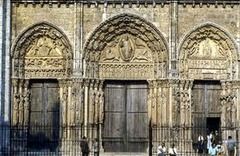
|
Royal Portal Facade, Chartres Date: 1150 Period: French Gothic Artist: Unknown French architect. Function: Meant to serve as an entrance to a place of worship; the tympanum designs remind the church member of the weight and responsibility of their commitment to the Christian faith, church, and it's adherents. However, the triforium has no particular function within the church side structure. Context: Columns were replaced by jambs (3D-like statues, integrated into the actual column). Late Romanesque, Early Gothic. The tympanum theme and composition recall Byzantine representation of the Theotokos. Descriptive terms: The sculptures of the west facade proclaim the majesty and power of Christ; to unite the three doorways iconographically and visually, the sculptors carved episodes of Christ's life in the capitals sort of like a frieze structure idea. Ideas relevant to the work of art: The theme was integration of Christ and His coming.Due to the influence of the time period from which it came, the figures on the jambs are not necessarily anatomically correct. There is a Romanesque influence present in the work. Materials: Stone Patron: visitors
|
|
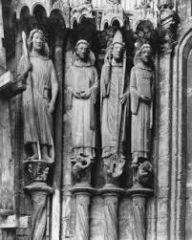
|
St Theodore, Chartres Date: 1250 Period:thirteenth century Gothic sculpture Function: a statue for decoration Context: It is a south-transept of Saint Theodore, the matryed warrior on the Porch of the Martyrs. The handsome long-haired youth holds his spear firmly in his right hand and rests his left hand on his shield. His body's torsion calls to mind Classical Greek statuary. Descriptive terms: Classical, Saint Theodore Chartres, sculpture, Ideas relevant to the work of art: In the sculpture, Theodore is portrayed as the ideal Christian knight and clothed in the cloak and chain-mail armor of Gothic Crusaders. Materials: Stone Patron: Christians, Saint Theodore |
|

|
Christ (Beau Dieu), Amiens Date: 1200 Period: French Gothic Function: serves as a trumeau statue of the central doorway in the west facade of Amiens Cathedral Context: The sculptor was able to fully model Christ's figure, enveloping his boy with massive drapery folds cascading from his waist. Descriptive terms: statue, realistic, Gothic, Christ's figure Ideas relevant to the work of art: The sculptor placed an architectural canopy over the figure's head. It portrays the latest Gothic style, mimicking the east end of a thirteenth century cathedral with a series of radiating chapels pierced by elegant lancet windows. Materials: stone, concrete Patron: visitors of the Amiens Cathedral, Christians
|
|
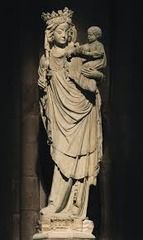
|
Virgin of Paris, Notre Dame Date: 1300 Period: Early 14th century Function: Sculpture located in the Parisian Cathedral of Notre-Dame Context: The sculptor portrayed Mary as a worldly queen, dcked out in royal garments and wearing a heavy gem-encrusted crown. The Christ Child is equally richly attired and is very much in the arms of hs young mother. Descriptive Terms: Virgina and child, Late Gothic art, worldly queen, French court style scultpure Ideas relevant to the work of art: The anecdotal characterization of mother and son represents a further humanization of the portrayal of relgious figures in Gothic sculpture. There is a playful interaction presented between the child and the adult. Materials: stone sculpture, carving Patron: visitors of the Paisian Cathedral of Notre-Dame
|
|
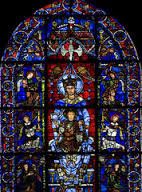
|
Virgin and Child, Chartres Date: 1200 Period:French Gothic Function: a tall lancet (window) in the choir of Cartres Catheral, Chartres, Context: The central sections, depicts the Virgin Mary enthroned with the Christ Child in her lap, and is surround with a red background. Mary is represented as young, beaultiful, wordly, Queen of Heaven, etc. Descriptive Terms: lancet, window, Chartres, stained glass, painted drawings, Virgin, Christ Chld, angels Ideas relevant to the work of art: The framing angels seen against the blue background, beside the original glasswork (red background) was added when the window was reinstalled in the 13th century choir. Materials: Stained glass Patron: Visitors of the Chartres Cathedral
|
|
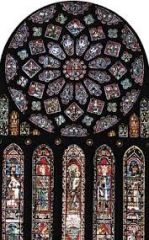
|
Rose window, Chartres Date: 1200 Period: Thirteenth-century Gothic Function:Tall lancets (windows) of Chartres Chathedral's north transpet. They were gifts from the Queen of France, Blanche of Castile, around 1220. Context: The lower spandrels of the window are decorated with royal motifs of yellow castles on a red ground and yellow three petaled iris fowers on a blue ground. The entrhroned Virgin and Child is again the central motif; Mary appears in the roundel at the center of the rose, which resembles a gem-studded book cover. Below, in the lancets, there are drawings of Saint Anne and Four Od Testament prophets Descriptive Terms: rose, lancets, Virgin and Child, gem-studded book cover, Saint Anne Ideas relevant to the work of art: Many Gothic stained-glass windows present narrative scenes, ad their iconographcal programs are sometimes as complex as those of the sculpted chrch portals. Materials: Stained glass; 43 inches in diameter Patron: visitors of Chartres Cathedral
|

